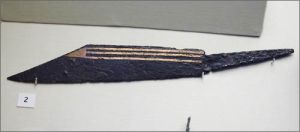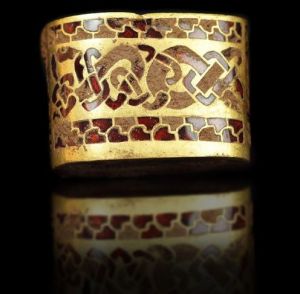Working as an apprentice swordsmith, I have handled hundreds of swords, but there is one style of blade that has always delighted me: The Anglo-Saxon Seax. I adore its simplicity and the chunkiness of the blade, despite having far fewer opportunities for refined decoration than, say, a swept hilt rapier or a smallsword.
One of the things I am going to teach myself to do is engrave and inlay in order to replicate the decoration found on the Sittingbourne seax and the other high level examples that have been excavated. Here are a few of the best :
My final target will be to make a sword hilted seax in the style of the recent Staffordshire hilt discoveries currently on display in the British Museum. May take a few years though!
I will probably cast and carve brass in place of the original gold, and enamel the recesses rather than insetting garnets, but the effect should be very similar and it will leave me a further, far more complex and expensive, project for later.
The seax at the top of the article is the first sword I made after getting my apprenticeship, I have also made a fair number of smaller ones as gifts to friends, I think pretty much everyone i know has got one now!
I always engrave a phonetic rendering of the recipient’s name onto the blade, mainly to make them a little more visually stimulating than just plain steel. I really need to pay more attention to my photography!












Elegant simplicity and yet savage at the same time. Fascinating how such lethal objects can command such beauty.
Jim
LikeLike
I agree, weapons seem to hold an artistic value that both transcends, but is also irrevocably tied to their function. Its a contrast I have always found fascinating!
LikeLike
How do you become an apprentice blade smith?!?! Also, incredible work! Your Seax look great!
LikeLike